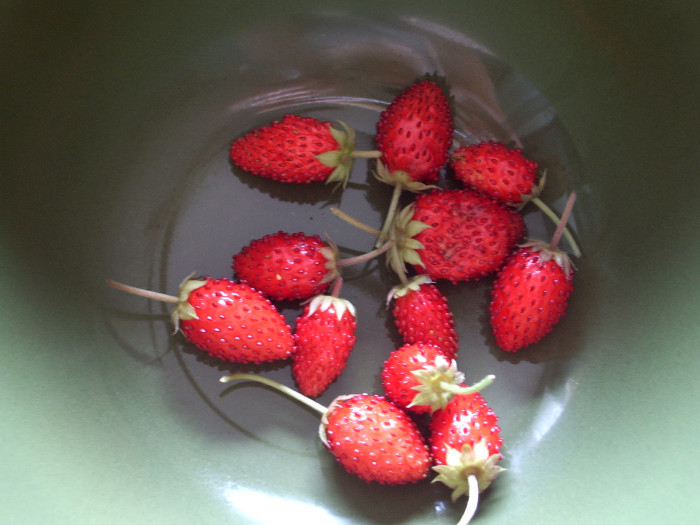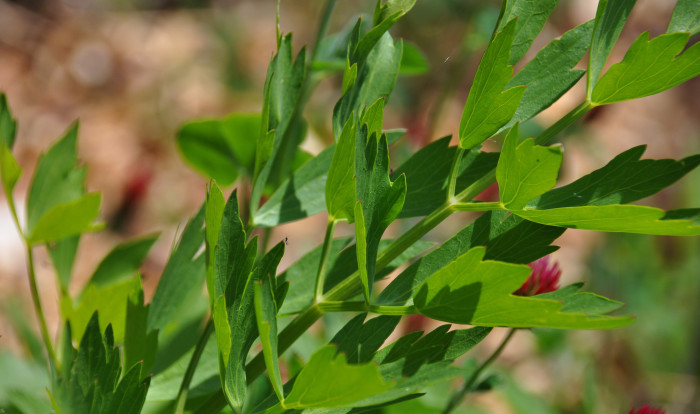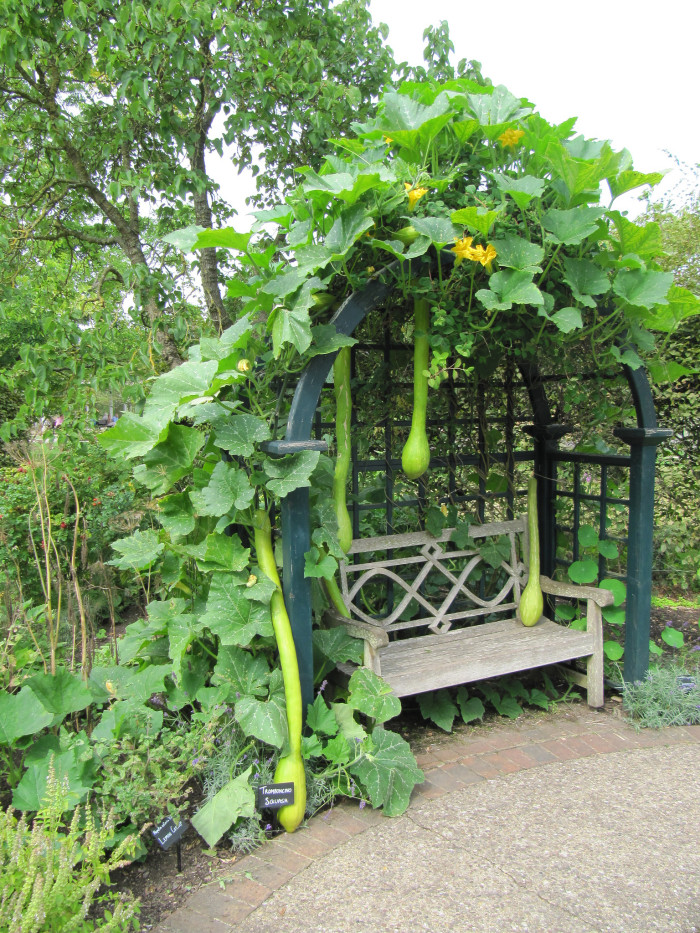Unusual Ingredients To Look For At The Market Right Now
Ever browse your farmer's market and wonder what that familiar-looking but weirdly named vegetable is and what you're supposed to do with it? Well it's summer, when the stalls are filled with lettuce, berry and corn variations, and while the safe bet is to grab the spinach or eggplant, why not try something more exotic?
We've sought the counsel of wise chefs over the years to discover new ingredients and play around with cooking with them. (Shout-out to writer Linnea Covington, who sourced the chefs behind these ingredients.) Here are unusual ingredients to look for at the market right now.
Alpine Strawberry
Unlike supermarket strawberries, the Alpine variety is bold, fresh and has an elongated shape, more like a tiny chili pepper than a fat raindrop. They are traditionally grown wild and offer an intoxicating flavor. At Bondir in Cambridge, MA, chef-owner Jason Bond cooks alpine strawberries down with red wine and oregano and treats the mixture like a marinara sauce, pairing it with foie-gras-infused white polenta to create a bright, rich dish that speaks to the season. Another way to use Alpine strawberries aside from eating them straight or baking them into dessert is to jelly-cook them with vinegar and cracked pepper. Freeze the concoction like a sorbet and use it to garnish fresh oysters.
Bloody Butcher Corn
Most people don't realize just how many types of corn are out there, especially when you count heirloom varieties. Chef Marcus Paslay of Clay Pigeon Food and Drink in Fort Worth, Texas likes to work with Bloody Butcher, with dark red kernels. "Not only does it have a different flavor, but with the contrast of color it gets people thinking about corn in a different way," the chef says. "It's not as sweet as you are used to with conventional corn. It has better earth tones, a lot more minerality and more of a starchy quality." Paslay soaks the red kernels overnight to remove some of the starch, then cooks it with house-cured bacon, shallots and tomatoes to make a savory relish (you can find the recipe here) that pairs with seared scallops. Other ideas on how to use this corn: Toss some cooked, cooled kernels in a salad to make your dinner guests do a double take or add to a light summer soup for a stunning starchy kick. When you shop for it in the market, make sure you are getting fresh corn on the cob, not the dried variety. People often use Bloody Butcher for ornamental purposes because it looks so pretty, but it's better for eating.
Celtuce
Is this a hybrid of celery and lettuce as the name suggests? No. Celtuce is a long green vegetable in the lettuce family that has a leafy top and thick stem that you chop up and eat, as well. "It has that sweet bitterness of lettuce and a core that is truly wonderful eaten raw or just wilted and braised with a little bit of butter," says Minneapolis chef Paul Berglund. "It also has popcorn notes and is nutty and bitter but with a bit of sweetness." Though it isn't common, you can find this green in some farmers markets marketed under a different name: asparagus lettuce. And since it's an Asian vegetable, look for it at your local Chinese market, where you might find under the name wosun or woju.
Donut Peaches
Stone fruits are busting out right now, and while nectarines and regular old round peaches get all the glory, we are more interested in the less popular but better sounding donut peaches. You know, those slightly flat white, pink and yellowish disks hiding next to their succulent orb-shaped cousins? Also called Saturn peaches, these white-fleshed beauties tend to prove sweeter but lower in acidity than other varieties. And, the fruit has a thinner skin and less fuzz. So, for those of us who can't get past the peach stubble, it's perfect. Plus, donut peach trees tend to produce more fruit and grow in more places, so they are sustainable, too. Use them the same way you would a regular peach: in a pie, as jam, blended into a smoothie or just munch it raw with the juices dribbling down your fingers.
Ginger Root
Ginger is one of those plants many people recognize immediately, but don't really notice, particularly when it's fresh and in raw form. Look for beige roots that are firm and slightly heavy with no gray or dark brown spots. Then, peel off the rough skin and dice up the flesh to add to marinades, stir fry, muddled into a cocktail or soaked in lemon and sugar to make a lemonade with a kick. Keep in mind, despite appearances, fresh ginger doesn't last much longer than three weeks, and even that is pushing it. To keep the root at its best, wrap it in a paper towels and store in a plastic bag in your refrigerator, or in the freezer, where it will keep for about two months.
Green Tomatoes
Why not try something new in your salad this month? Right now, next to your heirlooms and beefsteak varieties, there are green tomatoes, which offer a firmer, more tart experience. When shopping, make sure you don't get green tomatoes confused with heirloom emerald-shaded fruits, like the Green Zebra or Green Giant. A true green tomato is actually a normal red one that gets picked early, before the sugars that give the fruit its classic sweetness develop. "It's really tangy and great to pickle," says Paslay of Clay Pigeon Food and Drink. "They are heartier and can hold up to that vinegar, and if you drop them in the fryer they won't come apart like a ripe tomato will." You can also play with this ingredient raw. For example, dice and toss into a salad, thinly slice and add to a grilled pizza with ricotta or make a bright salsa. Make sure you get tomatoes that are firm to the touch and don't have any yellowing.
Lovage
Aside from being an awesome side project by musician Mike Patton, lovage is an herb with a flavor and aroma similar to celery. "People think it's almost like a curry spice — very aromatic and a little bitter, with a little heat," says Jason Bond of Bondir. "Lovage does have all that in one, plus it's green and fresh." Bond uses the leaves for all sorts of things, like cold summer soup with zucchini. He also removes the big hollow stems of the plant and candies them the same way you would a citrus peel. From there, the sugared herb becomes a candy straw or gets diced up and folded into a cake or pastry. "I use it the same way you'd use candied citrus," he says. "But it can be a big flavor if you use too much." So don't get too excited, and use your lovage wisely. Look for it in hearty green bunches the next time you visit the market. It should have emerald green leaves free of blight and discoloration, and it should not be wilted. You can keep it fresh in the fridge by sticking the ends in water or wrapped in a damp paper towel.
Sour Cherries
Unlike their sweet cousins, these sweet-and-sour orbs aren't normally eaten by the handful. (Unless, that is, you like the sensation of sucking on Sour Patch Kids.) Instead, take this tart fruit and use it to spruce up your baking repertoire by making pies, tarts, scones and jellies. You can also use sour cherries to create a flavorful sauce for duck or chicken. Some people even use them to make wine. Like all produce, there are many types of sour cherries, including the popular Jubileum and Montmorency, as well as hybrids like Danube, all ranging in color from bright red to purple-black to yellow-orange. To pick the best ones, look for slightly firm fruit without blemishes. Then, store them in your fridge unwashed until you're ready to use. But, don't wait longer than a couple days. Because these beauties are more perishable than regular cherries, you probably won't find them outside your local farmers market. Just make sure to get them soon. The season is short and sweet — or, sour, in this case.
Trombonecino squash
There are summer squashes, and then there are trombonecino squashes, a light green vegetable with a long neck that hails from the same family as the butternut varietal. "It's like a dense baby zucchini, but with less moisture, which gives it a similar but stronger flavor," says Bond. What's with the long, foreign-sounding name? The trombonecino is an heirloom varietal originally from Italy, so you might see it by its common American moniker, zucchetta (which also sounds pretty Italian). No matter what you call it, it's definitely an ingredient to look for. The chef suggests searing it on the grill at your next barbecue or simply shaving the squash raw to make a healthy salad with a light oil-and-vinegar dressing, blanched peas, radish and some fresh herbs. Make sure any you pick up are pale green or yellowish and don't have any holes or soft spots. If there's a flower on the end, even better — who doesn't like a stuffed fried squash blossom?






